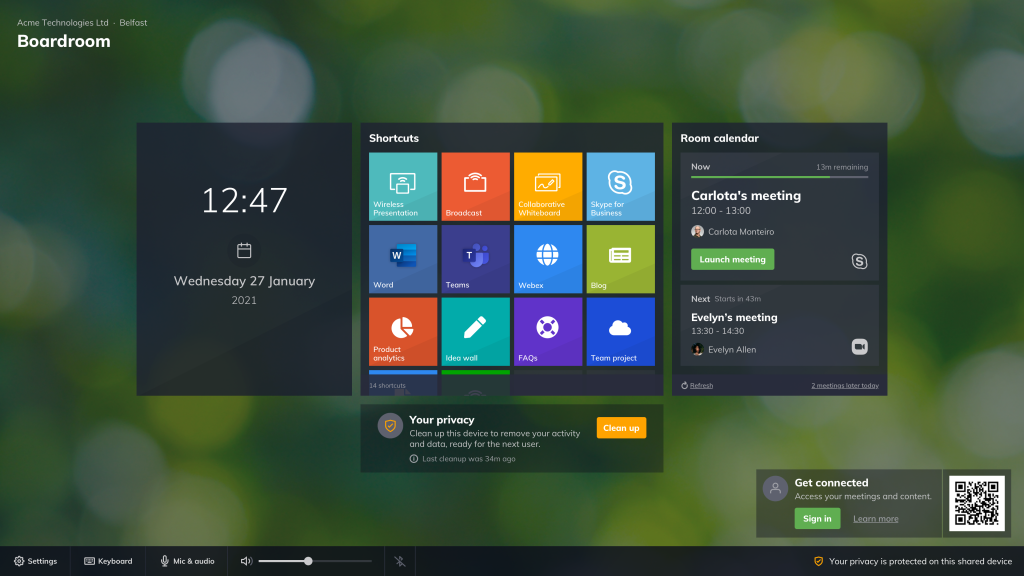
Webex, Teams, or Zoom? How to solve the issue of video conferencing interoperability
 Julie Adams
•
Nov 14, 2022
Julie Adams
•
Nov 14, 2022
What we cover in this article on video conferencing interoperability:
- What is interoperability
- Why video conferencing interoperability matters in the workplace
- The rise of the hybrid meetings
- How to make your meeting spaces video interoperable
Interoperability: you may or may not be familiar with the word, but you’re probably familiar with the concept. Microsoft Exchange talks to Gmail. Vodafone talks to Telefonica (02). But Zoom still can’t speak to Teams, and neither can Teams talk to Webex. Or to any other video platform for that matter. Why? Because video-conferencing still isn’t interoperable.
What is interoperability?
Interoperability is the property that allows the unrestricted sharing of resources between different systems. This can refer to the ability to share data between different components or machines, both via software and hardware. It is also defined as the exchange of information and resources between different computers through local area networks (LANs) or wide area networks (WANs). In a nutshell, interoperability is the ability of two or more components or systems to exchange information and to use the information that has been exchanged.
When it comes to video meetings, a lack of interoperability means that different platforms (for example, Zoom and Teams) are unable to communicate or share information with each other. You then have to choose one or the other to host the call. However, with many meeting spaces being vendor-locked – this can cause issues when it comes to launching video calls in the meeting space.

Why does video conferencing interoperability matter in the meeting space?
Let me paint the picture: you’re all gathered together in a huddle space, ready to take an important call with a client at 2 pm. But hang on – the client calls from a Zoom Room – you’re gathered together in a Teams-enabled meeting room. What happens? No call.
When it comes to video, a lack of interoperability across the conferencing platforms is a significant pain point for IT Administrators and end-users alike. IT Admins have to deal with the chaos of managing multiple platforms while monitoring the threat of Shadow IT platform use.
And for end-users (i.e., employees) – a lack of interoperability in video conferencing means reduced productivity, more technical issues, and less effective meetings. Historically, this might not have been such an issue, but considering the shift to remote working – video interoperability is now essential.
With 3 in 4 expressing a preference for a mix of home and office work – video conferencing isn’t going anywhere. It’s here for the long haul. And businesses need to be equipped for seamless and hassle-free video-conferencing – whatever the platform is.The big companies have picked up on this: namely Teams and Zoom. You can now launch a Zoom call from a Teams Room – but with a myriad of other video conferencing platforms out there, we’re still not seeing full interoperability the way we’d like to.
The rise of hybrid meetings

In light of the events from the last 3 years, hybrid working has become normalized for many organizations globally – with employees working partially between the office and partially remotely. This has also meant an increase in virtual meetings and, more specifically, hybrid meetings – where some attendees join in person while some join virtually.
Hybrid meetings offer many benefits for both employees and employers; they’re more inclusive, more cost-effective, and they can improve accessibility in the workplace. However, for these types of meetings to work, organizations need to be aware of some of the pitfalls of bad hybrid meetings. They must also ensure meeting spaces are equipped to give virtual attendees the same experience as those in the room. A big part of this is the user experience when it comes to setting up the room and using the equipment.
Employees have become very familiar with the slick process of launching video calls from their laptops. As a result, they expect to have the same seamless experience in the meeting room, whatever the video platform. Meeting room technology is, therefore, vital for creating a successful hybrid working environment.
How to make your meeting spaces video interoperable
With Launcher meeting room software, you can walk into any UC-equipped meeting room and instantly launch your scheduled video calls. With Launcher software installed on meeting room screens, spaces are equipped to accommodate whichever video-conferencing software you or your clients prefer to use. Whether it’s Webex, Zoom, Teams, Google Meet, GoToMeeting, BlueJeans, Skype for Business, Lifesize, Launcher makes your meeting room fully interoperable.

Plus, with Launcher’s Kiosk Mode, IT Admins are in complete control of what appears on the screen. Meeting rooms are set up and customized to work with the platforms and applications you choose, and PIN-protected settings keep the system out of reach from users.
Discover how the Pacific Community is using Launcher to enable video interoperability for each of its 27 member islands.
Unlock your meeting spaces from a single video vendor
Want to stay in the loop?
Keep up-to-date with everything DisplayNote – including new releases, job openings, and customer giveaways.
Don’t worry, we’ll not spam you and we’ll never share your email with anyone








